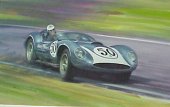SPECIAL ISSUE
McLaren M23 1973–1978
The men behind the McLaren M23's success
The technical background of the McLaren M23 when it debuted in 1973
The Yardley Macs – The McLaren M23 in its first season — 1973
The Fittipaldi years – Conquering the first drivers’ title and manufacturers’ cup
Back on top – Second drivers’ title and swansong
- Uwe Mahla on the 80th birthday of Hans Heyer
- Alwin Springer on Rolf Stommelen
- Eckhard Schimpf about Concorso d' Eleganza Villa d' Este 2023
- Ugo Vincenzi on Stefan Bellofs record lap on the Nürburgring
- Thierry Boutsen about his Benetton B187
- Patrick Long on his drive in the Rosberg Williams in HMSA Historic F1
When Denny Hulme took pole position for the South African Grand Prix, it was a first. The 36-year-old New Zealander had been racing in Formula 1 since 1965, had six grand prix wins to his name and had even won the 1967 world championship. But until that point, he’d never taken pole for a world championship race. The result was sensational for the team, too. Up to then, Peter Revson had taken McLaren’s sole pole in Canada in 1972.
Hulme had his brand-new McLaren M23 to thank for this breakthrough pole. He and teammate Revson had used the M19 from the previous year for the two opening rounds of the 1973 season in Argentina and Brazil. After a single day of testing at Goodwood, during which Hulme completed 70 laps, chassis number one was flown straight to South Africa. In the 14 days before the grand prix, there was more testing at the Kyalami circuit. The M23 was immediately quicker than its predecessor.
Kyalami was one of Hulme’s favourite circuits. In 1970 he had finished second there in the M14A, and in 1971 he’d led for a long time in the new M19 until he was struck with suspension damage a few laps from home. In 1972 he had won in the M19. And then on 2 March 1973, he stormed to pole position in the M23. The new McLaren cornered like it was on rails and was also one of the quickest cars on the straights. Revson and Jody Scheckter had to make do with the old M19 and qualified third (Scheckter) and sixth (Revson).
On 3 December in 1975, Teddy Mayer told the press that following Emerson Fittipaldi’s departure, he had immediately thought about James Hunt as a replacement. But it wasn’t quite true. Mayer’s immediate reaction had actually been to call John Hogan, the marketing boss at Marlboro. ‘We need to find a driver’ was all he said, and he left the search up to Hogan. After all, the drivers were paid by Marlboro.
If Mayer would have had his way, there’s a chance Jochen Mass might have been promoted to the number one role and a new number two driver hired. Hogan, a better judge of drivers than Mayer, was thinking bigger, thinking of a new star. He was the one who immediately knew who to hire: James Hunt was without a drive for 1976 because his former employer, Hesketh, had been dissolved a week before. On a Saturday evening, Hogan drove to London to make Hunt an offer. Due to the circumstances, the salary was only a fraction of what Fittipaldi had been earning.
On the Sunday, James Hunt discussed the offer with his brother Peter. The money wasn’t the main issue. Hunt was more concerned about whether he could beat Mass, who he knew was a tough competitor from their days in Formula 3. He also had a great deal of respect for the McLaren team and expected a very different environment to what he’d been used to at Hesketh. But the Hunt brothers knew they had no choice. On Monday, Peter called Hogan and accepted the offer…
Since 2017, owner Kai Nieklauson and technical partner and scout Mike Gensemeyer have been assembling a unique collection of racing cars carrying the legendary John Player Special design. The collection is aptly named the “Black and Gold Collection”, given nearly every exhibit is painted in those colours. “Exhibits” is a deliberate choice of word as it is no longer just about cars. These days there’s a plane and a boat as part of the collection as well.
‘It has been a long road to get here,’ says Nieklauson, as he reflects on his years as the owner of ChromeCars. ‘We have been presented with some unique opportunities and have consistently taken advantage of them.’ By that he means the positive circumstances that, ultimately, led to the founding of this collection.
‘I wanted to get into trading classic cars,’ says 52-year-old Nieklauson. ‘It became clear that I wanted to sell what was my core business at the time and reorient myself. I wanted to live some of the things out that I didn’t have time for in my everyday business life for 20 years.’ Living out that passion started with great excess. On his first trip to the US, Nieklauson bought 40 cars and imported them back to Germany. ‘My tax advisor pulled me aside and said, “Mr Nieklauson, this is all well and good but given your CV, if you sell a single one of these cars you will immediately be considered a trader, and we’ll have a problem. So please register a business”.’ Nieklauson heeded the advice. He knew from the start that there were some cars would never leave his halls, and some that would be bought and sold as commercial goods. It was a neat divide…
The Audi 50 Group 2 presented here has been in use in circuit racing and in hillclimbs for more than 45 years. Over the decades, it has been rebuilt four times. At the end of the recently completed restoration, the car received FIA HTP certification – and thus enjoys the prospect of many more wonderful years in international racing.
‘Cars of series production which may be submitted to certain modifications aimed at making them better suited to competition.’ This is the first sentence in Appendix J of 1976 for the ‘Touring Cars (Group 2)’ category.
This update of the Group 2 regulations which had been in force up to that point added a number of essential restrictions on parts for which there had previously been freedom. However, if you look at these new regulations as the starting point of a development that lasted until 1981, this Appendix J meant the approval of a lot of racing technology for ‘bread-and-butter cars’ such as the Audi 50. In particular, it introduced freedom with regard to mixture preparation, valves, valve guides and valve seats as well as the use of electronic ignition systems (still a novelty at the time), huge fenders, various rigid mountings and modern safety standards.
As a result, the Audi 50 from 1974 and then the VW Polo from 1975 became popular in German and European motorsport. The classes up to 1,150 and up to 1,300 cc always provided close and entertaining racing. Here, ‘ordinary folks’ like Inez Muhle, Manfred Haase, Michael Pötschke, Wolfgang Kudrass and many others battled it out. However, they did not use close-to-standard equipment as in the numerous one-make cups at the time, but much more sophisticated Group 2 machinery…
This product was added to our catalog on Friday 23 February, 2024.



